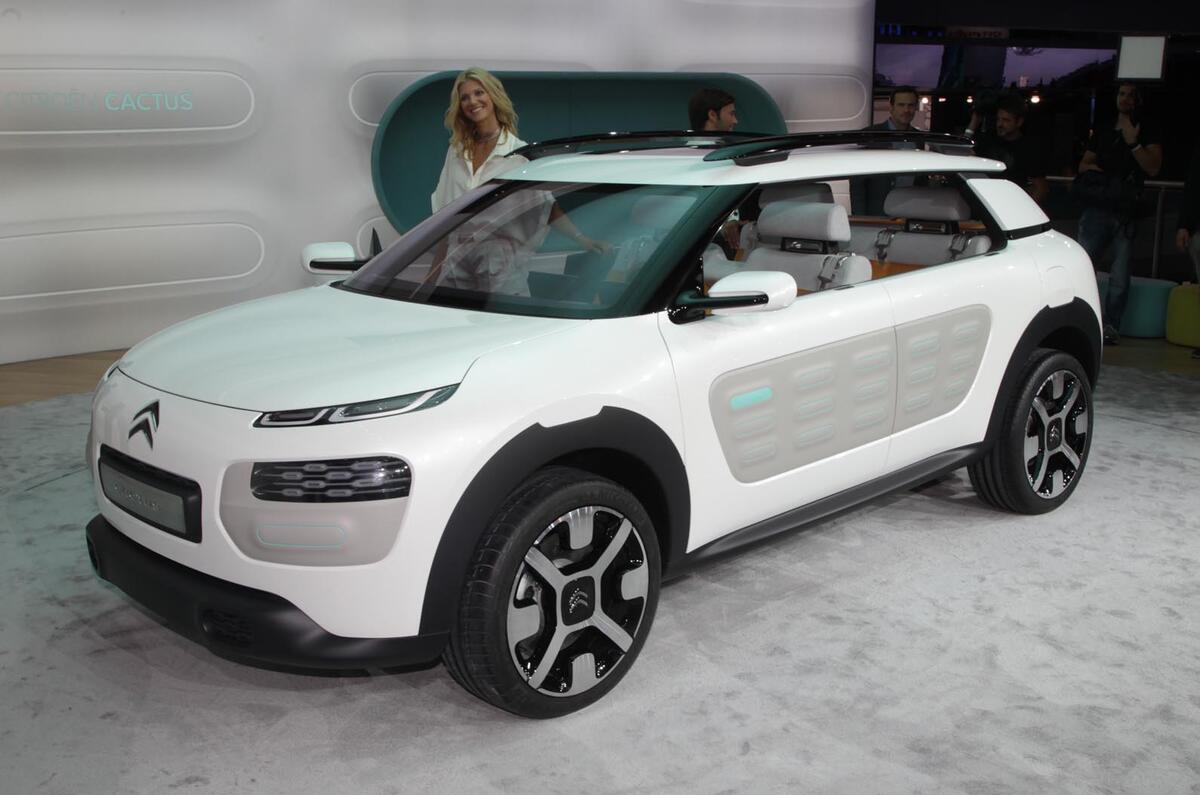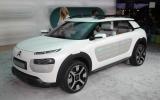Citroën could radically overhaul all its mainstream C-line offerings in the spirit of this Citroën Cactus Concept car, revealed at the Frankfurt motor show today, and due to go on sale largely unchanged in February.
The Cactus Concept will become the Citroën C4 Cactus when it goes on sale, and be offered alongside the standard car in the same vein as the Citroën C4 Picasso. More Cactus spin-offs of existing models are expected to follow. However, if the new look is deemed a sales success, Citroën officials say that they are optimistic that Cactus cars could eventually replace more mainstream, conventional offerings.
“For now, the standard C4 has many years ahead of it in its product cycle, so we have time to evaluate the success of the Cactus line,” said Citroën boss Frederic Banzet. “However, our research suggests that it will be a sales success. We have chosen to develop a line that will be loved by some and hated by some – it is better that way than being an average choice in an overcrowded market.”
The Cactus Concept is 4.21m long, 1.75m wide and 1.53m high, but with a relatively high ride height of 21cm. It is expected to sit on the firm’s new EMP2 platform when it goes on sale. The most obvious concept touch of the show car is that its B-pillars and side and rear windows have been removed to focus attention on the radical interior. They will be in place for production.
“We think that some of the established automotive design standards of today are lacking,” said Cactus design manager Mark Lloyd, who helped launch the hugely successful DS brand. "We wanted to reduce the complexity of living with a car and make interaction with the car less stressful. Simplicity and elegance were the goals. Citroën should be about innovation and well-being; this car is our manifesto for that.
“There are typical concept car flourishes, but they are all there to accentuate our goals – nothing is superfluous. You will clearly recognise the production car from this concept.”
Citroën describes the Cactus as “shedding the superfluous” but is at pains to stress that it is not pushing to build budget cars in the style of Dacia. Instead, it says it plans to use the new look to re-engage customers with the traditional Citroën values of comfort and style at a modest price premium over a standard C4.
Highlights of the interior’s new look include the entirely digital controls, which sit on a slimline dash on two separate screens, a sofa style front and rear bench, and the use of more natural materials on all surfaces. The central eight-inch touchscreen is used for all the car’s functions, such as sat-nav, air-con, audio and all driver aids.








































Join the debate
Add your comment
P.S. Don't forget the dynamics
I do hope PSA can find some time and money to make it drive better than recent efforts. Conventional, economical systems (Macpherson struts front, trailing arms and torsion bar rear) don't mean ride and handling have to be mediocre - look at your own history PSA...
I didn't mean to sound like an old git with my comments about the popular reaction to the C-Cactus concept above - does anyone disagree with what I said about the fundamentals of comfort in a car?
Tom Chet wrote: I didn't mean
I agree entirely. As our roads deteriorate day by day a decent ride, coupled with handling you can enjoy (doesn't have to be pin-sharp) are qualities you can really enjoy for a long time. So much of the tech and 'convenience' features on todays vehicles are just distractions from the main event, and often frustratingly unreliable, especially as a car gets older.
Great concept, but...
Like most above I think this looks absolutely fantastic, that the 'strip out the superfluous' hits the nail on the head for me and the whole thing is a real breath of fresh air: please build it, Citroen.
I do have a couple of reservations though. Surely one of the reasons to simplify a product is to make it cheaper, so I worry about some posters concerns that the Cactus line might be more expensive than a conventional C4 - surely that is wrong. Also if the aim is to strip out the superfluous and simplify, please sell it with a manual gearbox and as one poster above mentioned with conventional manual heater controls.
The following quote was rather depressing. I thought the C-Cactus and the original VW Up were the most exciting concept cars of the past decade.
"The idea for the Cactus was originally shown in the 2007 that was unveiled at that year’s Frankfurt motor show. However, potential customers suggested that the car was too stripped out and basic to be sold, suggesting that while they wanted to embrace a more elegant, minimalist ethos, they were not willing to do so at the expense of comfort or essential equipment."
Too many people seem to equate gadgets with 'comfort' and 'essential equipment'. In my experience, the essential elements of comfort in a car are space or a sense thereof (the most important), ride comfort and a smooth driver.
Very interesting
At last a vehicle in this sector which is not disagreeable to look at! Intriguing that the same man, a Briton, who was responsible for this vehicle, also styled the DS3.
If only the nominally British car companies could identify a stylist with similar flair. MINI I am thinking of you in particular!